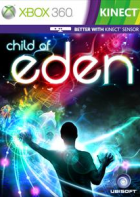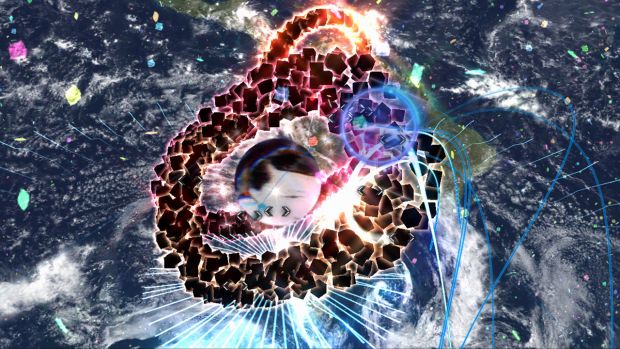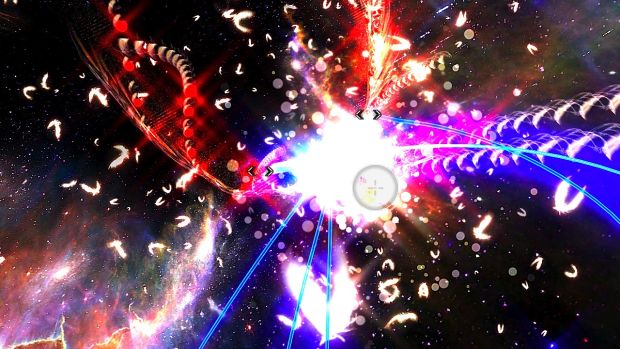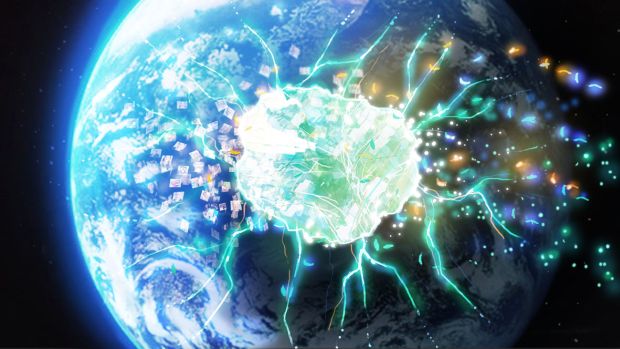Child of Eden Review


| Game Name: | Child Of Eden |
| Platforms: | Xbox 360 |
| Publisher(s): | Ubisoft |
| Developer(s): | Q Entertainment |
| Genre(s): | Music/Rhythm, Shooter |
| Release Date: | June 14, 2011 |
Believe it or not Child of Eden has a story, and while it’s somewhat a bit unclear Ubisoft makes Child of Eden feel like the player (you) is fully involved and the game is about you.
The game is without cutscenes for the most part, we feel this is a bit lacking, but that is what makes it feel like you are in the game itself. It takes place centuries into the future, when mankind has ventured deep into space, and the internet has become the source for human knowledge known as Eden. Deep within this system are the memories of the first child born in space, called Lumi (Eden) the trouble is that she’s under attack from a virus, so it’s your job to fight and destroy the virus. If you can successfully “purify” (that’s what it’s called) the parasites, you awaken more of Lumi’s memories, and images of this young girl are used to great emotional effect as you come closer to waking her from her slumber.
Child of Eden is a shooter infused with some very simple rhythm action elements. An onscreen cursor is used to attack enemies; blue for lock-on and pink for rapid-fire. The idea is to use the blue lock-on fire mode to highlight up to eight enemies at a time (known as an octa-lock, also achievement related) and then use the rapid-fire mode to shoot down enemy projectiles, as well as certain enemies (who are always colored pink) that is where the tracer weapon comes in to play to eliminate them. Extra points are awarded for firing an octa-lock in time with the music, with “good” and “perfect” messages appearing onscreen to let you know when you’re doing it correctly. Finally, euphoria (a screen-clearing bomb, essentially) can be used to clear the screen of enemies if things become too overwhelming to handle.
While the mechanics remain the same whether you’re using the Kinect or a standard controller, the experience is quite different and changing the way you might play using a controller or the Kinect. The default standard control scheme has you holding the A button to lock on, the X or right trigger button for rapid-fire, and the B button to activate euphoria. On the Kinect, you wave your right hand to lock on to enemies and then flick your hand forward to release the shot; you use your left hand for rapid-fire and put both hands in the air to activate euphoria. There’s also an alternative control scheme where you clap your hands to change weapons. Either way, you’re only required to move your hands rather than your entire body when using the Kinect. This feature allows for longer game play instead of getting wore down or too tired to play.
Both control schemes work well, but the standard controller is easier to use (for us at Game 2 Gamer anyway). The Kinect tracking is good and the camera sensitivity can be adjusted in the menu system, but there are times when weapon changes will unintentionally move the camera and leave you feeling disorientated. But what the Kinect loses in ease, it makes up for by being the more immersive experience. But we did notice the Kinect doesn’t always pick up every little movement and doesn’t fire and can do a tad frustrating at times.Aside from allowing you the freedom to move in time to the music, it gives you the feeling of conducting an electronic orchestra as your movements directly affect the music and sound effects. With either control scheme, you can elect to put standard controllers in your pockets and have them vibrate in time to the music, which complements the rhythmic shooting.
Each of the five levels is based around a theme, such as passion or matrix, and each motif has a striking and memorable visual/aural identity. Beauty, for example, sees you flying over lakes, shooting flowers and butterflies, and avoiding enemy projectiles that emit the sound of water droplets as you take them down. Every level ends with a boss battle, and these epic multistage encounters are undoubtedly the highlight of the game. Early on, you face off against a giant whale that turns into a phoenix, and later on, colliding planets transform into giant, running men. Later bosses change into forms which are only susceptible to one type of weapon.
If you’re willing to submit to the sensory experience of Child of Eden, you’ll find it euphoric, artistic, and downright spine tingling at times. You can finish the five main levels and see the credits in a little over an hour, but thankfully there’s plenty of replay value in the form of new difficulty settings, alternative visual styles, and an unlockable challenge level. There’s also content that requires repeated plays to unlock, such as concept art, music videos, and items that can be played with in Lumi’s garden. Unlocking all of these items means completing the levels many times over, improving your purification rate, and performing specific tasks within each level, such as 50 perfect octa-locks.
The game seems simple and very repetitive, but it can also be a challenge and entertaining as well, with music and brightly lit screens the game is a leap from the norm. Ubisoft’s Child of Eden is available now for the Xbox 360.
Game 2 Gamer’s Final score 3.5 / 5









Still getting used to the Kinect controls + I am traditionally not too good at these types of games in the first place. It is pretty stunning visually & quite enjoyable.
I doubt I will ever get those 50 perfect octa-locks though.